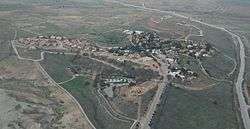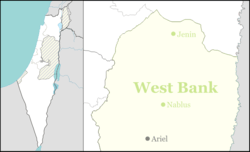Shadmot Mehola
| Shadmot Mehola | |
|---|---|
 | |
 Shadmot Mehola | |
| Coordinates: 32°20′53.78″N 35°31′59.7″E / 32.3482722°N 35.533250°ECoordinates: 32°20′53.78″N 35°31′59.7″E / 32.3482722°N 35.533250°E | |
| District | Judea and Samaria Area |
| Council | Bik'at HaYarden |
| Region | West Bank |
| Affiliation | Hapoel HaMizrachi |
| Founded | 1979 |
| Founded by | Nahal |
| Population (2015)[1] | 553 |
Shadmot Mehola (Hebrew: שַׁדְמוֹת מְחוֹלָה, lit. Mehola Fields) is a national-religious moshav shitufi and Israeli settlement in the West Bank.[2] Located in the Beit She'an Valley, it falls under the jurisdiction of Bik'at HaYarden Regional Council.[2] In 2015 it had a population of 553.
The international community considers Israeli settlements in the West Bank illegal under international law, but the Israeli government disputes this.[3]
History
The village was established as a Nahal settlement named Shelah in 1979, and was converted to a civilian settlement by residents of Mehola in 1984.[4] As Mehola itself it was named after the biblical city of Abel-mechola (1 Kings 19:16), which was located in the area.
Construction
According to the mayor of the nearby Palestinian village of Maleh, Arif Daraghmeh, residents of the village are not allowed to build permanent structures despite living there for generations, as well as receiving demolition orders that compel them to live in tents or mudbrick housing, without permission to link up to the water grid, while Shadmot Mehola settlers dwell in a fenced community, with two-storey homes, street lamps and playgrounds.[5]
References
- ↑ "List of localities, in Alphabetical order" (PDF). Israel Central Bureau of Statistics. Retrieved 16 October 2016.
- 1 2 Shadmot Mehola Bik'at HaYarden Regional Council
- ↑ "The Geneva Convention". BBC News. 10 December 2009. Retrieved 27 November 2010.
- ↑ Carta's Official Guide to Israel: And Complete Gazeteer to All Sites in the Holy Land. State of Israel Ministry of Defence Publishing House. 1993. p. 417. ISBN 978-965-220-186-7.
- ↑ 'Palestinians in West Bank's Area C suffer in limbo,' Los Angeles Times, 18 May 2013